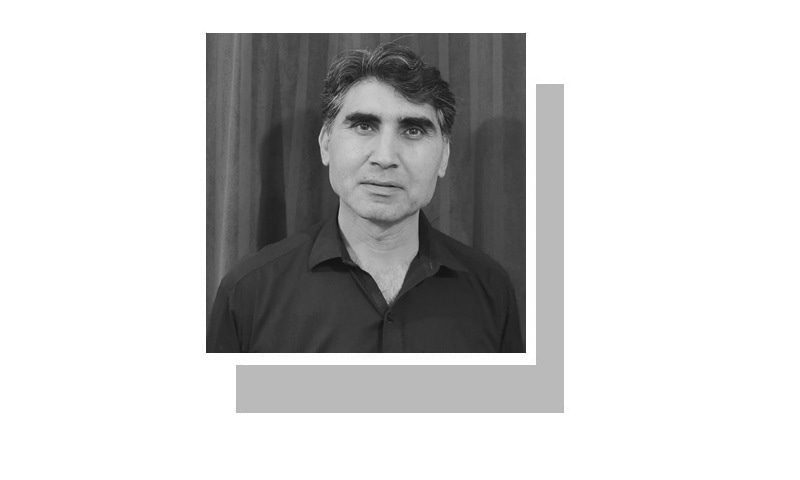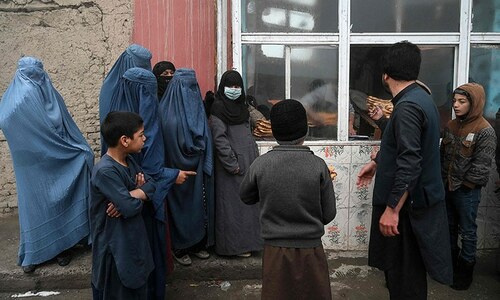WHILE the issue of recognition of the Afghan Taliban remains pending, a humanitarian crisis is looming: the dilemma of the virtually stateless people of Afghanistan, especially women, is not limited to food or medicine shortages. Their existential crisis actually emanates from the Taliban’s political incapacity. Turning the idea of ‘reformed Taliban’ on its head, this menace threatens Afghanistan’s future, while exposing our own ‘cruel optimism’ — a fantasy embodying irrational expectations of a militant band.
Ever since Kabul was systematically made to ‘fall’ to the Taliban, public freedom has teetered on the precipice of political indecision. Despite giving reassuring statements to gradually open all schools, the Taliban haven’t yet fulfilled their promises. Earlier, a blanket amnesty was announced. Yet, ex-government officials are being targeted. Assaults on women are also being reported resulting in growing protests by them. Restrictions on women’s movement hinder their socioeconomic activities in cash- and food-starved Afghanistan. Instead of political solutions, the Taliban seek ‘liberal’ ways to suppress freedom of expression and deny rights. Astutely appropriating the humanitarian discourse, they recently suggested that international aid be unconditionally extended to them — an effort to depoliticise the tragedy to reinforce their claim of representing the entire Afghan nation. Taking the Afghan people hostage, this approach borders on blackmailing the international community.
Read: Taliban erasing Afghan women from public life, say UN experts
Though the Afghan people, particularly women, suffer most, they haven’t lost hope. A viral video shows some of them have opened a secret school in Kabul, a house turned into a teaching-learning centre away from the Taliban’s terrifying gaze. Such clandestine efforts have also been reported from other parts of the country. Caught in a militarised region, these women, on the one hand, have carried the torch against obscurantism, but, on the other hand, are plagued not only by non-democratic regimes but also paternalistic discourses.
Back in the 1990s, when infighting intensified among mujahideen factions, the regional sponsors of the decade-long Afghan ‘jihad’ found it hard to control these fiercely independent warlords. Hence, the Afghan Taliban’s rise was an outcome of the need for finding an alternative. How did it happen? Legend goes that a notorious warlord in Kandahar let loose a reign of terror. Controlling the checkpoints, he abused women daily and in one incident kidnapped two newly-wed women. A vengeful group of madressah students (Taliban) spontaneously emerged to dismantle these checkpoints and marched from Kandahar to Kabul and later went on to rule the country. But the Taliban’s identity, belonging to the porous Pak-Afghan border, remained as ambiguous for common Afghans as their ideology. Then 9/11 happened and the US toppled the militant band for harbouring terrorists: Al Qaeda. In this fiction, an Afghan woman is turned into a mere appendage, with a faceless role to legitimise a religiously inspired group’s gaining political value through militant means.
‘Which Taliban are you asking about? Inside our houses or outside?’
Turning women into victims and then rescuing them has proved a successful strategy in the Af-Pak region (‘atrocity stories’ were also used in ex-Fata to strengthen numerous armed groups, especially after the Jamia Hafsa operation). First, women are barred from workplaces and schools and later this segregation is used as a means for unrelenting suppression. While violent warlords abused women at checkpoints, the Taliban confined such abuses to the home. Both instances of paternalistic rules are dehumanising, oppressive and violent.
This militarism, however, only partially explains the violence against women. Traditional forms of social control define another aspect. In my recent research, I asked a displaced Afghan journalist about her ordeal under the Taliban. Her reply caught me unprepared: “Which Taliban are you asking about? Inside our houses or outside?” From enduring ruthless disciplinary tactics at home to facing foreign-sponsored predatory militants on the streets, the role of Afghan women is as diverse as their work is deadly.
In 1987, Meena Keshwar Kamal, a founder of the Revolutionary Association of the Women of Afghanistan, was kidnapped and then decapitated in Quetta (her husband had been killed earlier). She was a vocal critic of the US-sponsored ‘jihad’ and, therefore, suspicion fell on a warlord, a blue-eyed boy of the Pakistani establishment. When the region was erupting in officially patronised militarisation, RAWA was the progressive face of resistance, the lone voice for a secular and democratic Afghanistan. Living in close proximity to the dreaded ‘jihadists’ in Peshawar and Quetta, RAWA members condemned fundamentalism, imperialism and Soviet puppets and raised their voice for freedom and rights. Its activists established handicraft centres and arranged nursing courses for orphans and widows. Reminding the world that an entire nation cannot be turned into passive victims, they also were the first to introduce the idea of secret schools. In this struggle against the backdrop of criss-crossing militarisation, many lost their lives, yet did not lose their hope of seeing a forward-looking Afghanistan.
Because their existential struggle is always intense, their ideals have been grossly politicised so that they border on neo-colonialism. Soon after the US bombing of Afghanistan, the Bush administration said: “The fight against terrorism is also a fight for the rights and dignity of women.” Laura Bush went further: “Because of our recent military gains in much of Afghanistan, women are no longer imprisoned in their homes.” Afghan women never saw their salvation in the bombing of their country; they also condemned Western countries’ support for militant rule in Afghanistan. This nuanced position — struggling for disarmament through a non-violent movement — exposed them to more threats.
Though militarised violence is a complicated phenomenon in the Af-Pak region, understanding it depends upon how effectively we challenge the given stories. The Taliban’s emergence was not a spontaneous outcome of a power vacuum, nor is their present resurgence an isolated event that is outside imperialism’s regional legacy. As a paradoxical idea, the Taliban is a religiously inspired group deployed as a strategic option for obtaining political legitimacy through militancy. Dependent on this contradiction is the regional cycle of local violence. Key to the end of this crisis is the radical position of Afghan women. Moved by their revolutionary defiance, Arundhati Roy said, “Each of us needs a little RAWA.”
The writer is the author of the Dark Side of News Fixing: The Culture and Political Economy of Global Media in Pakistan and Afghanistan.
Published in Dawn, January 21st, 2022














































